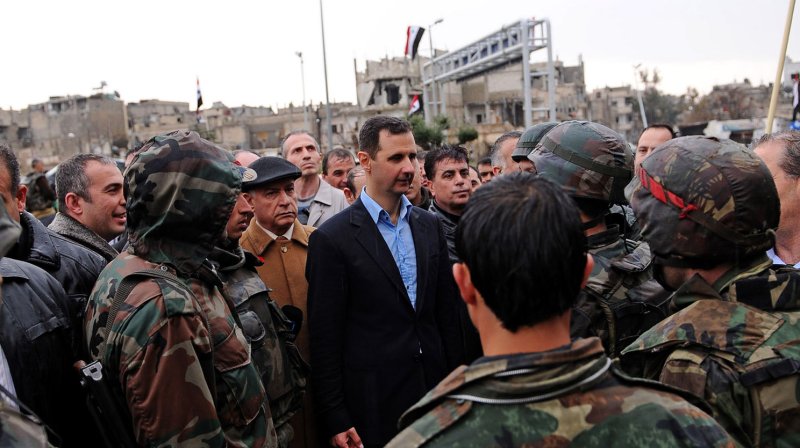Syria's President Bashar al-Assad (C) speaks to soldiers during a tour in the Baba Amr neighborhood of Homs in this handout photograph released by Syria's national news agency SANA on March 27, 2012. UPI |
License Photo
BEIRUT, Lebanon, April 23 (UPI) -- While Syria's autocratic regime has been waging a brutal crackdown against a 13-month uprising to topple President Bashar al-Assad, the regime has been steadily upgrading its military capabilities against Israel and foreign intervention to aid the rebels.
Russia has been one of Damascus' key diplomatic allies in the international furor over the bloodbath in Syria in which by United Nations count more than 9,000 people, the vast majority of them civilians, have been killed.
Moscow was Syria's main arms supplier during the Cold War and, under President Vladimir Putin, Russia has sought to bolster Assad's regime and restore Moscow's influence in the Middle East.
Iran, Syria's strategic ally, has also been a key supplier. Several shipments of arms to Syria have been intercepted in recent months. In the last two weeks, two freighters have been intercepted, one by the Israeli navy in the eastern Mediterranean. No arms were found, however.
But these incidents underline Israeli fears that Assad is bracing for a regional conflict, possibly as a consequence of threatened Israeli strikes on Iran's nuclear facilities or foreign intervention as happened in Libya.
Israel's military commanders are increasingly concerned that sizeable deliveries of Russian weapons systems to Syria, some of which could be handed on Hezbollah in Lebanon, could change the balance of power in the volatile region.
Advanced air-defense systems in particular are causing concern since they could pose new threats to Israel's long-held aerial supremacy.
Syria's acquisition of the SA-17s and SA-11 Gadflies, which the Russians call Buk M-1 and M2, plus Pantsir S1 surface-to-air batteries appears to have followed the Israeli air force's destruction of a nuclear reactor being built in Syria by North Korea 4 1/2 years ago.
In the Sept. 6, 2007, strike Israeli warplanes blinded Syrian air defenses through electronic jamming, giving a squadron of F-15s a clear run to pulverize the reactor in the desert at Deir el-Zour, 80 miles from the Iraqi border.
Western military sources say Syria's armed forces have taken delivery of an unspecified number of SA-17 surface-to-air missile batteries, NATO codename Grizzly. Israel's Haaretz daily says the SA-17 contract was signed "several years ago," although deliveries took place several months ago.
The Israelis say two SA-17 batteries are operational and deployed along Syria's border with Lebanon, Israel's northern neighbor, while a third is undergoing training.
The SA-17 has a range of 19 miles and can intercept multiple targets at once at altitudes of up to 40,000 feet.
"As a result," Haaretz said, the Israeli air force "has modified the way it flies in the north and particularly when conducting missions over Lebanon, where it continues to fly to gather intelligence on Hezbollah activities."
Hezbollah reportedly has received surface-to-air missiles from Syria. If the Iranian-backed movement does have them, it hasn't fired any.
It may well be holding them for a new conflict with Israel so it can for the first time challenge its air supremacy.
Aviation Week reported March 12 that "at least some" of around 480 top-of-the-line SA-24 Grinch shoulder-launched anti-aircraft missiles that disappeared in Libya during its 2011 civil war were smuggled to Iran and eventually wound up with Syria and Hezbollah.
The Grinch can down aircraft up to an altitude of 11,000 feet.
These too affect Israel. Iran seemingly wants to build a first line of anti-aircraft defense over Syria, its ally, against any Israeli airstrikes. The SA-17 has an operational ceiling of 82,000 feet.
But Syria too could become a target for Israel, particularly if its large stockpile of chemical weapons, believed to be the fourth largest in the world, looks like falling into insurgent hands.
In May 2011, Russia delivered 72 supersonic Yakhont SS-N-26 anti-ship cruise missiles to Damascus under a 2007 contract worth $300 million despite calls for a U.N. arms embargo on the regime as it unleashed its forces against protesters.
Russia's Interfax agency noted that the system known as the P-800 in Russia "allows coverage of the entire coastline of Syria from possible attacks from the sea."
That too alarmed the Israelis, whose navy has long-dominated the eastern Mediterranean.
The SS-N-26, with a range of 190 miles and a maximum speed of 1,900 mph, carries a warhead of 440 pounds of high explosive, enough to sink a large warship.





